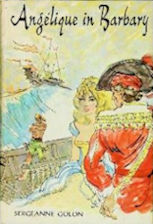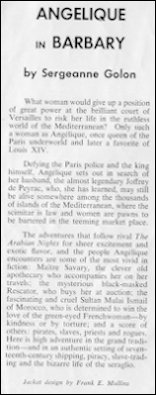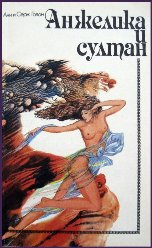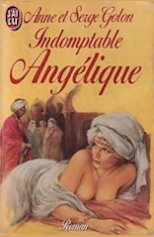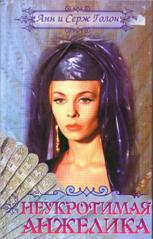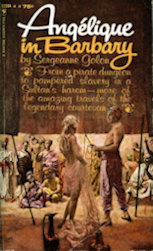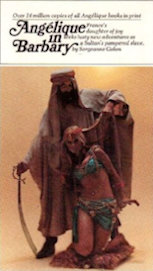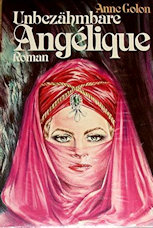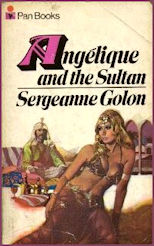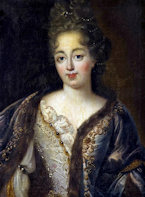Angélique and the Sultan
Angélique and the Sultan is, uniquely in the series, known by an alternative title for the American market as Angélique in Barbary.
 By the time we, the readers, reach this stage of the series we have discovered much about our eponymous heroine. In this book, I think Angélique starts discovering a lot more about herself. We know she is shrewd despite the fact that she deliberately neglected her studies at the convent. I suspect that there wasn't an awful lot in the curriculum that would have stretched her imagination, but she will certainly have absorbed much unconsciously. She certainly, by her formative years, already had a great
By the time we, the readers, reach this stage of the series we have discovered much about our eponymous heroine. In this book, I think Angélique starts discovering a lot more about herself. We know she is shrewd despite the fact that she deliberately neglected her studies at the convent. I suspect that there wasn't an awful lot in the curriculum that would have stretched her imagination, but she will certainly have absorbed much unconsciously. She certainly, by her formative years, already had a great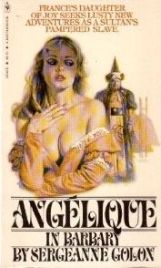 experience of life (and death) and luckily for us an ever-enquiring mind. As a child she saw the potential in the mule business and bartered on behalf of her father. Prior to that she had witnessed a potential wrong-doing at her uncle's estate and kept that knowledge secret for use at a later date. I don't suppose she actually planned to use it - but she was shrewd enough to know that what she had done had value. She rebelled against the planned marriage but knew it would save her father and her love for him was beyond measure, she knew she had to fight for his and her own survival. And on and on - she survives a poison attempt at court on herself and Florimond, she calls on the resources of the Underworld, she becomes a business woman, she returns to Court with full honours. I suppose it could all have come to an end there and then couldn't it except for the absence of Joffrey de Peyrac.
experience of life (and death) and luckily for us an ever-enquiring mind. As a child she saw the potential in the mule business and bartered on behalf of her father. Prior to that she had witnessed a potential wrong-doing at her uncle's estate and kept that knowledge secret for use at a later date. I don't suppose she actually planned to use it - but she was shrewd enough to know that what she had done had value. She rebelled against the planned marriage but knew it would save her father and her love for him was beyond measure, she knew she had to fight for his and her own survival. And on and on - she survives a poison attempt at court on herself and Florimond, she calls on the resources of the Underworld, she becomes a business woman, she returns to Court with full honours. I suppose it could all have come to an end there and then couldn't it except for the absence of Joffrey de Peyrac.
The King has informed Angélique that Joffrey did not die at his hands raising hopes that he may have survived and then makes his biggest mistake - he informs Angélique that although he did not manage to kill her husband off, he had died from his wounds and the privations heaped upon him as a result. And with this her Royal Master hopes to ingratiate himself with Angélique, this woman of all women?
Angélique has other plans, she now has hope, great hope and in the opening of this particular volume of the series, her son Florimond calmly informs her that he has known for some considerable time that not only did his father survive but that he is convinced that Cantor had managed to track him down. Armed with the knowledge that there is proof of Joffrey's survival and that the King has placed restrictions on her freedom of movement, the greater rebel in Angélique materialises, her business acumen kicks in and her companion of choice is old Savary who knows the Mediterranean like the back of his hand.
The book will explain all this a whole lot better and I had originally decided I would concentrate on two themes that run through the book - the East India Trading Company and Candia (known to us today as the island of Crete). However, the other day I was looking for something completely different and came across the fascinating history of harems and so I've decided to add a third element and hope you will indulge me.
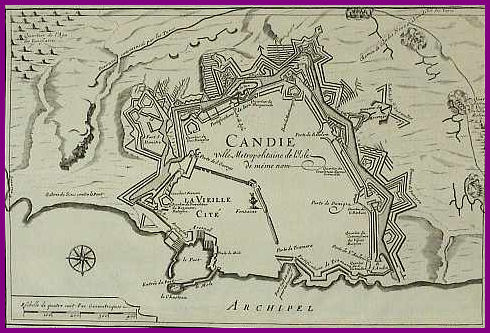
Map of Candia dated 1688
Book Reviews
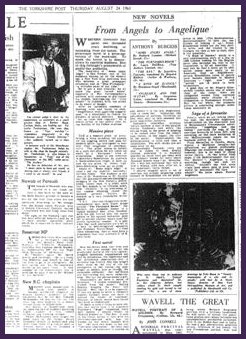
My own Review for this particular book and which forms the pattern of the site has not yet been written. This would be largely due to my either not having written one for Amazon all those years ago (and I can't imagine why I wouldn't have done so) or it is lost somewhere in the archives. I will attempt to re-read the book and post a review that will do it justice - despite the fact that less than 20% of the whole dwells on the desert escape, that particular sequence is always at the forefront of my mind when I think of this book!
However, I do have something of interest and that is a copy, kindly sent to me by the Yorkshire Post, of the original review by Anthony Burgess written in 1964. It is a very badly perished photocopy and I have reproduced the wording in the sidebar - but for a piece of history, in more ways than one, I think that it is absolutely brilliant and I'm a lucky girl to be able to share! Please enjoy these versions which I have enlarged to enable easier viewing.


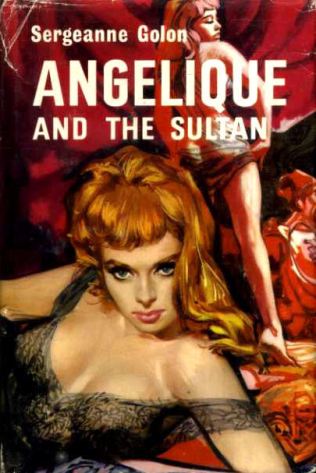
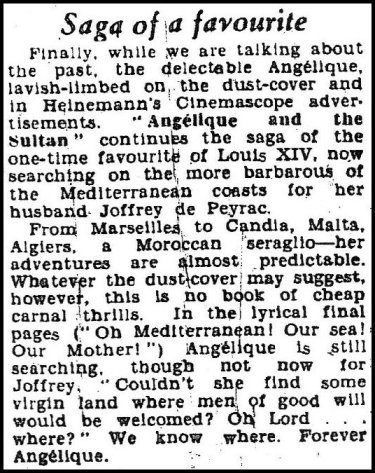
The very 'lavish-limbed' cover described in the review by Anthony Burgess and the review itself.
Whilst checking over the page construction on my iPad to make sure all the various mediums accepted the page formatting I found myself staring at the wording used by Burgess and gaped open-mouthed at the thought of "Heinemann's Cinemascope advertisements." - Now there's a challenge if ever there was one to see if there is anyone out there who witnessed a billboard ad and are there any images anywhere? I would have been too young to necessarily appreciate that sort of advertising technique although I am really loving the current Meerkat campaigns via billboard!
Weird Versions
"This is a reproduction of a book published before 1923. This book may have occasional imperfections such as  missing or blurred pages, poor pictures, errant marks, etc. that were either part of the original artefact, or were introduced by the scanning process. We believe this work is culturally important, and despite the imperfections, have elected to bring it back into print as part of our continuing commitment to the preservation of printed works worldwide. We appreciate your understanding of the imperfections in the preservation process, and hope you enjoy this valuable book."
missing or blurred pages, poor pictures, errant marks, etc. that were either part of the original artefact, or were introduced by the scanning process. We believe this work is culturally important, and despite the imperfections, have elected to bring it back into print as part of our continuing commitment to the preservation of printed works worldwide. We appreciate your understanding of the imperfections in the preservation process, and hope you enjoy this valuable book."
I have included this book cover and the product description from Amazon because it has been on the market for some considerable time. I find it perplexing and amusing and cannot see the point of its existence. The title of the book is the same as that used by the British publishers in translation for the original 'Indomptable Angélique' written by Anne Golon. The use of the combined name continues the tradition of the English translations - however, the book is but 36 short pages in length and possesses two ISBN numbers.
- ISBN-10: 1175395048
- ISBN-13: 978-1175395047
I'm almost tempted to buy it to see what it is all about! However at £12.99 upwards (if you do a Google search on the ISBN numbers) I think I will happily give it a miss!
And of course the other really mystifying thing is, that the publishers and sellers of this very peculiar item appear to think that they are reproducing a pre-1923 book - Anne Golon is an infant prodigy indeed!
Enough of the weird stuff!
Candia
This beautiful reproduction depicts the city of Iraklion (Heraklion) on Candia in the mid-17th century and is the copyright of the Hebrew University of Jerusalem and the Jewish National and University Library
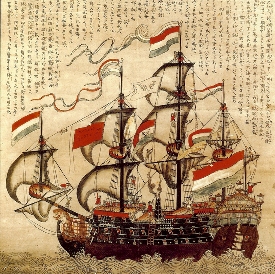
An intriguing representation of a Dutch East India ship of the time.
Turkish Occupation in Crete
Extract from History of Crete during the period in which this book is set and a little beyond to the time when Crete gained its independence from the Turks.
"Crete was under constant threat of invasion by Turkey during the last years of Venetian rule. The invasion began in 1645 with the attack on Chania. Sixty thousand Turkish troops landed from a fleet of 400 ships and Chania soon fell. Rethimnon was the next target and in 1646 fell into Turkish hands. By 1648, the Ottoman Empire was in control of Crete, except for Iraklion where the siege lasted twenty-one years. Finally, on 27 September 1669, Iraklion surrendered. The lengthy battle had cost 117,000 Turkish lives and nearly 30,000 lives among the Cretans and Venetians.
Incredibly extensive material destruction followed the conquest: some churches were levelled, others were converted into mosques, and roads and fortifications fell into disrepair.
Many inhabitants fled Crete to escape the persecution of the Ottoman government, while thousands of others became prisoners or fled to the mountains. Large numbers of Turkish settlers arrived and added to the misery of the shrinking Christian population. The Cretans suffered under higher taxes than those in other regions of the Ottoman Empire, farmers became serfs, and private property was seized.
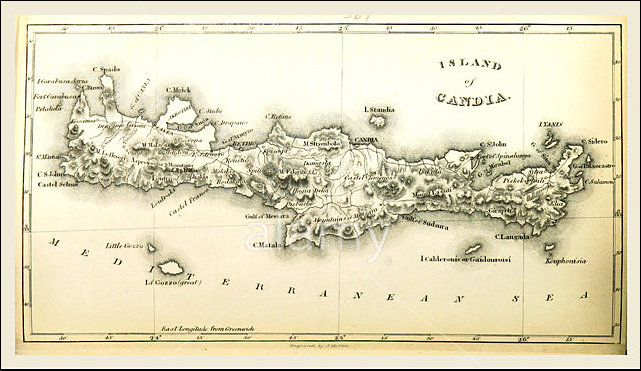
These slave-like conditions led to almost constant uprisings against Turkish control. Daskaloyannis led the first major rebellion in 1770, which was initially successful but was eventually put down by the Turkish forces. Severe reprisals against the Christian population followed this and most other uprisings.
The Greek War of Independence began in 1821 and Cretan participation was extensive. The Turks responded by seeking the aid of the Pasha of Egypt, and brutal campaigns crushed the island’s resistance. In 1832 a Greek state was established which, however, did not include Crete and the island passed to the Egyptians, in acknowledgement of their assistance.
Aided by volunteers and reinforcements from free Greece, the «Great Cretan Revolution» began in 1866 and the rebels scored a series of victories. However, as more Turkish forces landed on the island, reprisals, usually against non-combatants, became common. The holocaust at Moni Arkadiou in 1866 became a tragic symbol of Crete’s struggle for independence: hundreds of women and children took refuge in the monastery and, refusing to surrender to Turkish forces, blew up the powder magazine, burying themselves and 1,500 Turkish soldiers under the rubble. Finally, after years of struggle, the Great Powers (Britain, France, Italy and Russia) decided that Turkey could no longer maintain control and intervened with the expulsion of Turkish forces in 1898 which led to the formation of the independent Cretan Republic."
East India Trading
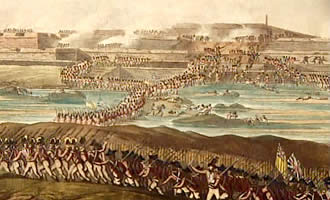
The British versus French versions of the East India Trading Companies
Extract from the Encyclopaedia Brittanica:
"French East India Company, byname of (1664–1719) Compagnie Française des Indes Orientales (French: “French Company of the East Indies”), or (1719–20) Compagnie des Indes (“Company of the Indies”), or (1720–89) Compagnie Française des Indes (“French Company of the Indies”), any of the French trading companies established in the 17th and 18th centuries to oversee French commerce with India, eastern Africa, and other territories of the Indian Ocean and the East Indies.
The Compagnie Française des Indes Orientales was established by Jean-Baptiste Colbert, finance minister to King Louis XIV. It had difficulty gaining the financial support of French merchants, and Colbert is thought to have pressured many of them to join. He persuaded François Charpentier of the French Academy to write a glowing advertisement about the benefits of joining the company, asking why the French should purchase gold, pepper, cinnamon, and cotton from foreign merchants. Louis XIV wrote to 119 towns, ordering merchants to gather and discuss subscribing to the company, but many refused. By 1668 the king himself was the biggest investor, and the company was to remain under his control.
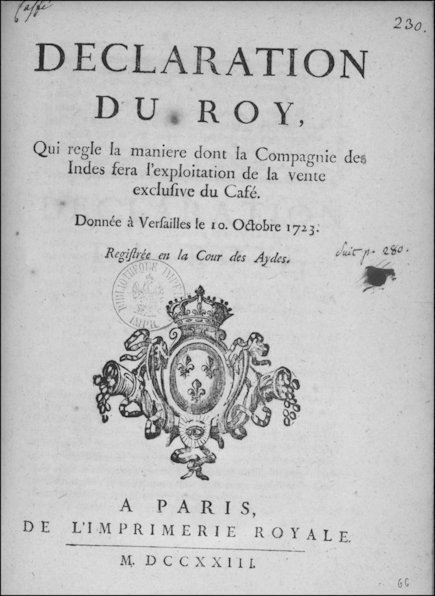
The official 'Declaration du Roy' creating the 'Compagnie Française des Indes Orientales'
In constant competition with the already-established Dutch East Indies Company, the French company mounted expensive expeditions that were often harassed and even confiscated by the Dutch. The French East India Company flourished briefly from 1670 to 1675; but by 1680 little money had been made, and many ships were in need of repair.
In 1719 the Compagnie Française des Indes Orientales was absorbed by the short-lived Compagnie des Indes. This company became entangled in the disastrous financial schemes of the fiscal administrator John Law, and so it suffered severely in the ensuing French economic crash of 1720. The company was then reorganized under the name Compagnie Française des Indes.
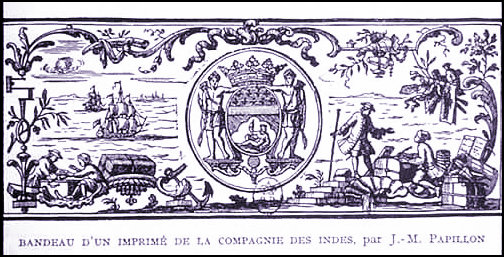
The 'Compagnie Française des Indes Orientales' company logo by J.M. Papillon
Harems
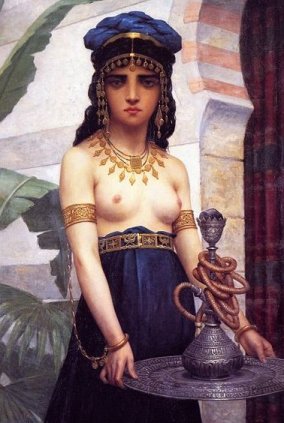
The Harem Servant, Paul Trouillebert, 1829-1900, French
'The Abduction From The Seraglio' - a comedy opera by Mozart
Not being a fan of Opera (except for a few Gilbert and Sullivan examples) I had no idea that Mozart had written one, let alone that the subject was humorous - I've always rather felt that Harems and all they stand for are a bit sinister. Anne Golon did very little to change my view especially in 'Angélique and the Sultan'. The original French title 'Indomtable Angélique' conveys much more clearly the real nature of the content and subject matter covered by this volume. The direct English translation of the word 'indomitable' is familiar to most readers and the thesaurus give us a wealth of alternative and more popularly used suggestions, amongst others - 'courageous', 'indefatigable', 'inviolable', 'persevering' and concludes the section concerning this word with "Not to be subdued; untamable; invincible; as, an indomitable will, courage, animal.." - so much more evocative than either 'Angélique and the Sultan' or 'Angélique in Barbary' as this book was entitled in the UK and USA respectively.
I have already shown some examples of the book covers, many of which rely heavily of the 'harem' aspect of the book despite its varied content. The film posters also dwell heavily on the exotic harem element which is a terrible shame as it detracts from the much richer storylines that tantalisingly throw breadcrumbs to be followed in the vain hope of answers to the demise or perhaps not, of Joffrey de Peyrac, Count of Tolouse, believed executed at the Place de Grève. However, as usual I digress.
The discovery of this opera prompted me to read the full article in the Daily Mail dated 21st August 2015 and the following is taken from the article as I am sure it echoes harem life in general in the time frame of the book even though it is based on harems in Turkey rather than North Africa where Angélique found herself :
"Sex slaves of the Sultans: Mozart's opera about a Turkish harem. The steamy truth behind his tale will make your hair curl!"
The secrets of the harem have enthralled Western visitors to Constantinople, now Istanbul, for centuries. Who would not be seduced by stories of a gated palace with secret corridors, home to 370 women — 12 wives or Sultanas, concubines and virgins — and 127 eunuchs?
This coquettishly comic opera, which Daily Mail readers can see on the Glyndebourne tour this autumn, tells of the efforts of a young Spanish nobleman, Belmonte, as he sets out to rescue his fiancée Konstanze from Pasha Selim, a Turkish despot who has abducted her to come and live as part of his seraglio.
The story includes pirates, slave traders, threats of torture, murderous Turks, trembling maidens and love triumphant.
But it is the seraglio itself and what went on behind its heavily-guarded walls that provided Mozart with his greatest inspiration. Cambridge scholar Norman Penzer summed up popular understanding of this Ottoman curiosity in the introduction to his book Harem.
‘Most of us still imagine that the Sultan is — or, rather, was — a vicious old reprobate, spending all his time in the harem, surrounded by hundreds of semi-naked women in an atmosphere of heavy perfume, cool fountains, soft music and over-indulgence in every conceivable kind of vice that the united brains of jealous, sex-starved women could invent for the pleasure of their lord.’ The truth, as Penzer discovered on trips to Istanbul, was even more charged with erotic and deadly intrigue. The words harem and seraglio are used interchangeably, but they have subtly different connotations. Harem is borrowed from the Arabic word haram — meaning that which is unlawful. The word suggests protected, inviolate, a sanctuary. A harem is a woman’s part of a palace or house where no male stranger may enter. Seraglio, meanwhile, is derived from the Italian serraglio — a cage for wild animals. It is a word that invites ideas of captivity, of wild unrestrained passions within — and of the prurient interest of outsiders.
The original and greatest of harems was that of the Topkapi Palace in Constantinople, modern Istanbul, where for hundreds of years wives, concubines and eunuchs lived in extraordinary splendour — and total isolation from the outside world. More than 300 rooms were grouped around 44 courtyards. There were bath houses, a mosque, gardens, fountains, aqueducts, aviaries, even a boating lake on which a Sultan could sail a small vessel and push the palace jester into the water to amuse himself. The harem’s ten kitchens served delicacies: dates, plums and prunes from Egypt; honeys from Romania and Hungary to sweeten drinks of cool sherbet; olive oils from Greece; pigeons and guinea fowl; and melons under ice from Mount Olympus. Turkish Delight was flavoured with mulberries, white grapes, apricot kernels and rosewater.
The harem was sumptuous, but a prison. Every window over the Bosphorus — the straits dividing Europe and Asia — was barred with an iron grille and a 50-strong guard stood by the main gates. At night, their number was swelled by janissaries, an infantry unit armed with yatagans — short, curved sabres. Inside the palace, the women were under the watch of the eunuchs.
There was a hierarchy: white eunuchs from Georgia, Hungary and Croatia were entrusted with administrative and secretarial roles, while black eunuchs from Abyssinia and Sudan had more mundane servants’ duties. Male slaves were fully emasculated with a pewter needle and sharp sickle-shaped knife. Seraglio doctors inspected the eunuchs not only when they entered service, but every few years. ‘Just to see,’ wrote Norman Penzer, ‘that everything was in order and that nothing had grown again.’ Watched by the eunuchs within the palace and surrounded by guards outside, the women of the harem were exquisite birds in a gilded cage. The penalty for rebellion was swift and merciless.
The Kislar Agha, chief eunuch, would send word to the janissaries giving the name of any woman who stepped out of line. She would be seized, tied in a sack weighted with stones and thrown into a small rowing boat, attached to a larger vessel by rope. The janissaries would then sail out into the Bosphorus and with a few sharp tugs of the rope, capsize the smaller craft. On one horrific occasion, the Sultan Ibrahim, who ruled between 1640 and 1648, decided to murder his entire harem — so that he might have the pleasure of assembling a new one. As many as 300 women are thought to have been drowned. There’s an old Sultana’s tale of a diver in search of shipwreck treasure who reached the bottom of the Bosphorus. All he found was many hundreds of weighted sacks, each the size and shape of a dead woman, swaying in the currents.
The seraglio of the Topkapi Palace was the grandest — and cruellest — of the empire, but in the minds of western Europeans it was only one of a vast number of Ottoman pleasure palaces where perfumed virgins reclined on tasselled cushions and rapacious pashas — dignitaries appointed by the Sultan — smoked bubble pipes. Every bathhouse became a place of imagined debauchery, where a daughter, sister or fiancée might be abducted and enslaved.
It wasn’t only Mozart who fuelled this fear and eroticism. Victorian painters such as John Frederick Lewis, Frederic Leighton and Frank Dicksee travelled to North Africa and the near East to paint scenes of languid women reflected in turquoise pools or coquettishly curled on leopard pelts. Frank Dicksee’s portrait of the fictional ‘Leila’ in apricot silk is typical of this sultry style of painting.
For although a man such as Mozart’s hero Belmonte dreaded the abduction of his beloved to a harem by some wicked pasha, he was, at the same time, tantalised by the fantasy of finding himself in a tiled courtyard surrounded by virgins competing for his affection and desire."
Sir Frank Dicksee's 'Leila'
John Frederick Lewis - 'Life in the Harem'
These two images as created by John Frederick Lewis and Frank Dicksee are quite different to the images created for modern publishing!
Moulay Ismael Ben Sharif
(b. circa 1645 in Sijilmassa d. 22 March 1727 at Meknes)
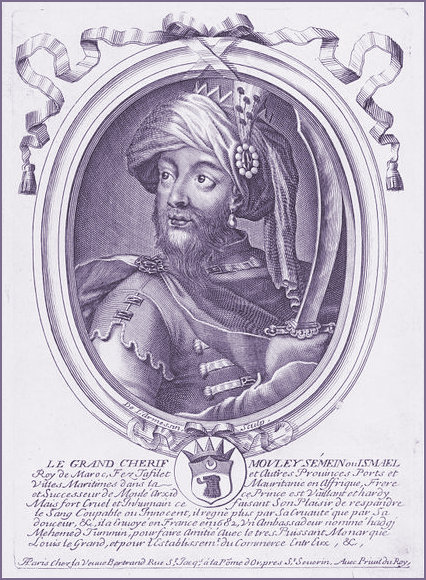
Engraving by Nicolas de Larmessin I, depicting a portrait of Sultan Moulay Ismail of Morocco (reigned 1672-1727), entitled 'Le Grand Cherif Mouley Sémein ou Ismael'. Printed in Paris, ca. late 17th century. - Image and strapline courtesy & © of the V&A
Snippets ....... courtesy of 'thenotsoinnocentsabroad.com'
- Sultan Moulay Ismail Ibn Sharif believed he was a descendent of the Prophet Mohammed — and used that as an excuse for some very bad behavior
- Sultan Moulay Ismail Ibn Sharif was propelled to the throne of Morocco in 1672. His brother had been riding horseback after a victory banquet and was killed when his horse galloped beneath the low-hanging branches of the palace orchard.
- Ismail's reign as sultan, from 1672-1727, was longer than any other ruler in Moroccan history. Whether he should be remembered more for his beautiful creations or his cruel tyranny is a matter of dispute — but everyone agrees that Ismail was one of the most important rulers in Moroccan history.
- Men who merely glanced at one of his wives or concubines were punished by death.
- He killed his servants at whim.
- Ismail was a sex addict — and fathered more children than anyone else in history.
- He had 500 concubines, which no one else could even look at.
- The Sharif family claims to be descendants of the Prophet Mohammed.
- The sultan's favorite wife was once a concubine who convinced him to punish his son in a horrific manner.
- Ismail created a massive self-generating army.
- He also had an astoundingly large prison that mostly held Christians.
- The sultan and the Sun King were allies.
(Sound familiar? We know Anne Golon researched everything and she was spot on about the life of this maniacal ruler - the website used for the snippets thenotsoinnocentsabroad expands these headlines which you can read by clicking on the links)
It's interesting that Anne got Angélique out of Morocco before Moulay Ismael started casting his eye around the Court of Louis XIV, but, if Joffrey returns to Versailles around 1680 which is where we think 'Victoire' ends, that would make Marie Anne 14 or thereabouts (allow between 2-4 years for accuracy) and therefore already of marriageable age. She is widowed in 1685 pinpointing her age at 19. Still young enough to retain her looks and to be an attractive proposition in the political marriage games of the time. Would she have stood a chance if Angélique was there? Just as well it was only the ambassador who came with the proposal. I was also ticked pink by the observation "The Sharif family claims to be descendants of the Prophet Mohammed" - In the case of actor. Omar Sharif, I could easily believe this!
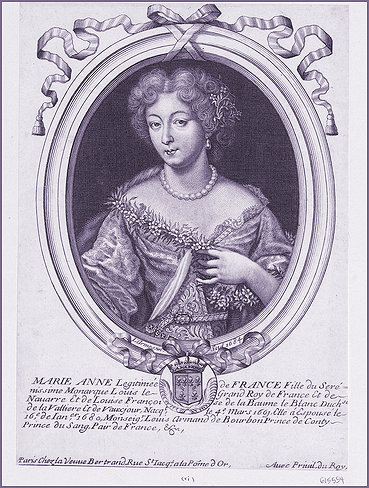
Marie Anne de Bourbon, the eldest legitimized daughter of the king and his mistress Louise de La Vallière
Engraving of Marie Anne de Bourbon, Princess of Conti. Half length with hair in ringlets, pearl earrings and necklace, lace tucker, and embroidered gown. Within an oval border with coat of arms and French inscription below, including publisher's address 'A Paris Chez la Veune Bertand Rue St Iacqs a la Pome d'Or Avec Privil du Roy.' Cut down. - image & strapline courtesy & © of the Royal Collection Trust
The Knights Templar / Knights of Malta / Knights of St John
Angélique turns to a Knight of Malta to assist her in escaping the slave market little knowing that a rescue had already been planned for her. As a result she stretches the budget limitations of the Knights and deals a heavy financial blow to her 'buyer' from whom she then escapes only to eventually find herself in the clutches of Mulai Ismael!


Two Knights of Malta/St John around the time of the action of the book, the Cross of St John will be familiar to those who are aware of the modern St Johns First Aiders who still use the emblem. The origins of the order provided free hospitalisation for poor and sick pilgrims.
"In 2013 at the high St. Peter's altar in the Vatican, Cardinal Tarcisio Bertone, led a special Mass to celebrate the 900th anniversary of the founding of the order by Brother Gerard, a Benedictine monk who opened a hospital for sick and poor pilgrims in Jerusalem at the time of the Crusades.
In 1113 Pope Paschal II formally recognised the independence of the Knights with a Papal bull, the original of which is still held in Malta's National Archives. The Knights have had a long history of displacement around the Mediterranean.
After being evicted from Jerusalem by Saladin towards the end of the 12th Century, they set up a new headquarters in Cyprus, and subsequently on the island of Rhodes where they created an independent state. During the Middle Ages they were more warriors than hospitallers.
For two centuries they were the masters of Malta but they were again evicted, this time by Napoleon who occupied the island on his way to Egypt.
They finally settled in Rome in 1834, where they continue to enjoy many of the privileges of statehood, such as the power to appoint and receive ambassadors, print stamps, and issue passports, without actually having a real state to govern. (Source BBC News)"
Page refreshed : 23rd July 2020 (G)





